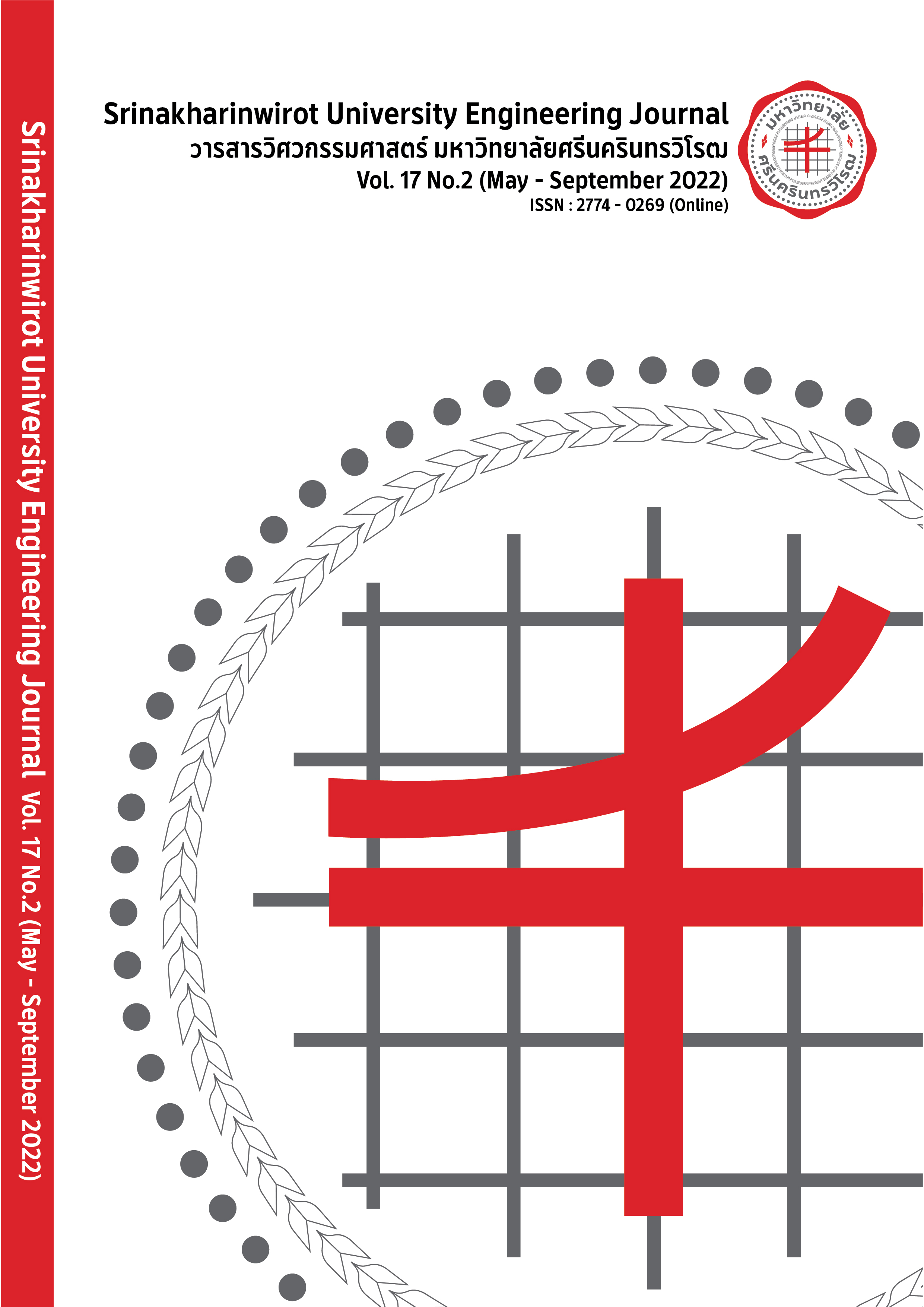Drying of Cherry Tomatoes Using Forced Convection Solar Greenhouse in Association with Infrared Heating
Main Article Content
Abstract
This research was aimed to compare the drying of preserve cherry tomatoes in forced convection solar greenhouse in two different systems: System 1, solar greenhouse installing ventilation fan; System 2, solar greenhouse installing ventilation fan and infrared heater fixed drying temperature at 45-60 °C. The two systems were compared to open sun drying. Drying rate, drying time, and product quality after drying including color, water activity, sweetness and specific energy consumption were investigated. The samples with average initial moisture content at 81.88 %d.b. were dried until the final moisture content reached the same level of the products in the market at 11- 25 % d. b. The results showed that the average drying rate in System 2 was the highest at 1. 173 kg/ h and took the shortest drying time at 12 hours, where specific energy consumption was 3. 47 kWh/ kg which was 68. 79% less than System 1, in a range of 0. 54- 0. 55. The water activities of both systems were less than 0. 6 and were also less than the one from open sun drying with statistical significance at P ≤0.05. Fungal growth, bacterial growth and microbial growth were not occurred at those water activity values, resulting in longer preservation. Sweetness values of all systems were in a range of 28. 33- 29. 50 % Brix and not different with statistical significance at P ≤0.05. The total color different ΔE comparing to before drying of preserve cherry tomatoes dried in System 2 was the least. The brightness values of the samples from all systems were in a range of 29.11-29.84. They were different from the beginning of the drying with statistical significance at P ≤0.05. The yellowness values of the samples from System 2 before and after drying were close.
Article Details

This work is licensed under a Creative Commons Attribution-NonCommercial-NoDerivatives 4.0 International License.
Copyright belongs to Srinakharinwirot University Engineering Journal
References
S. Janjai , Solar drying technology. 1sted. Nakhon Pathom: Petchkaset Printing Co., Ltd; 2017.
Department of Alternative Energy Development and Efficiency. (2021, Jan 2). “Solar heating” [online]. Available : https://ienergyguru.com
A. Taikhao and S. Teekasap, “Natural convection and forced convection solar dryers,” EAU HERITAGE JOURNAL Science and Technology, vol.7(1), pp. 23-31, May. 2013.
C. Sritus, “An investigation of the performance of a large-scale greenhouse solar dryer using polycarbonate cover,” M.S. thesis, Dept. Physics., Silpakorn University., Thailand, 2008.
J. Piwsaoad, “Performance of solar greenhouse dryer for drying para rubber sheets” M.S. thesis, Dept. Physics., Silpakorn University., Thailand, 2014.
T. Ongprasert and K. Jitjack. “A study of solar greenhouse drying in association with infrared heater for dehydration cherry tomatoes,” Kasem Bundit Engineering Journal. vol.10 pp.62-83, December. 2020.
K. Jitjack, S. Thepa, K. Sudaprasert and P. Namprakai. “Improvement of a rubber drying greenhouse with a parabolic cover and enhanced panels,” Energy and Buildings, vol. 124, pp. 178-193, July. 2016.
S. Nabnean, “Design construction and performance investigation of a solar dryer for drying tomatoes” Ph.D. thesis, School of Energy, Environment and Materials., King Mongkut’s University of Technology Thonburi., Thailand, 2015.
N. Keeratiyadatanapat and P. Toomthong, “Drying of wolffia arrhizal in a fluidized bed dryer,” Koch Cha Sarn Journal of Science, vol. 38(2), pp. 12-21, December. 2016.
S. Nabnean “An investigation of the performance of large – scale greenhouse solar drying system with auxiliary heaters” M.S. thesis, Dept. Physics., Silpakorn University., Thailand, 2009.
R. Kumwan, S. Thiangchanta and S. Kesai, “Determination of drying rate of jackfruit by infrared dryer,” Industrial Technology Lampang Rajabhat University Journal, vol. 11(2), pp. 67-77, December. 2018.
W. Jeentada, B. Niyomvas and A. Thaikul, “Experimental study on drying conditions of solar fish dryer with temperature controlled by open-closed ventilating system,” The Journal of KMUTNB, vol. 28(3), pp. 525-536, September. 2018.
A. Bharathkumar, SL. Jagadeesh, G. Bhuvaneshwari, SN. Patil, DL. Rudresh, M. Viresh Hiremath and I. Prabhakar, “Influence of pre-trearment on total soluble solids, titratable acidity and sugars of raisin,” International Journal of Chemical Studies, vol.6(5), pp. 230-232, August. 2018.
N. Wisaiprom, N. Kadsayapanand and W. Palasai, “The comparative study of shrimp drying process with low humidity air and hot air drying” Princess of Naradhiwas University Journal, vol.11(1), pp. 83-94, April. 2019.
N. Rattanapanon, Food Chemistry, 4th Ed., Odean Store Publisher, Bangkok, 2000.
P. Fellows, Food Processing Technology Principles and Practice, 2nd Ed. Woodhead Publishing, Ltd., Cambridge, 2000, pp. 575.


